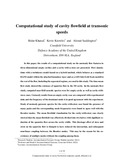- CERES Home
- →
- Cranfield Defence and Security
- →
- Staff publications (CDS)
- →
- View Item
JavaScript is disabled for your browser. Some features of this site may not work without it.
| dc.contributor.author | Khanal, B. | - |
| dc.contributor.author | Knowles, Kevin | - |
| dc.contributor.author | Saddington, A. J. | - |
| dc.date.accessioned | 2012-08-23T23:02:10Z | |
| dc.date.available | 2012-08-23T23:02:10Z | |
| dc.date.issued | 2009-12-31T00:00:00Z | - |
| dc.identifier.citation | Khanal B, Knowles K, Saddington AJ. (2009) Computational study of cavity flowfield at transonic speeds. In: 47th AIAA Aerospace Sciences Meeting including The New Horizons Forum and Aerospace Exposition 2009, pp. 701-719 | |
| dc.identifier.uri | http://dspace.lib.cranfield.ac.uk/handle/1826/7509 | |
| dc.identifier.uri | https://doi.org/10.2514/6.2009-701 | |
| dc.description.abstract | In this paper, the results of a computational study on the unsteady flow features in three-dimensional empty cavities and a cavity with a store are presented. Flow simulations with a turbulence model based on a hybrid method, which behaves as a standard RANS model within the attached boundary layer and as a LES Sub-Grid Scale model in the rest of the flow, including the separated regions, are used in this study. The time-mean flow study showed the existence of spanwise flow in the 3D cavity. In the unsteady flow study, computed near- field acoustic spectra were for empty cavity as well as cavity-withstore cases. Unsteady results from an empty cavity case are compared with experimental data and the frequency of the dominant mode is in good agreement with the experiment. Study of unsteady pressure spectra for the cavity-with-store case found the presence of many peaks and the corresponding mode frequencies were found to agree well with the Rossiter modes. The mean flowfield visualisation for the cavity-with-store case clearly showed that the mean flowfield was effectively divided into two halves with signifiant reduction of the spanwise flow across the cavity width. This blockage effect of store and strut on the spanwise flow is thought to have reduced the interaction, and subsequent non-linear coupling between, the Rossiter modes. This may be the reason for the coexistence of multiple modes without the coupling among them. | en_UK |
| dc.title | Computational study of cavity flowfield at transonic speeds | en_UK |
| dc.type | Conference paper | - |
Files in this item
This item appears in the following Collection(s)
-
Staff publications (CDS) [1209]
